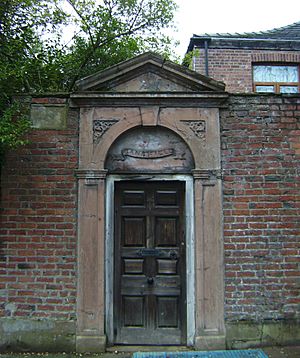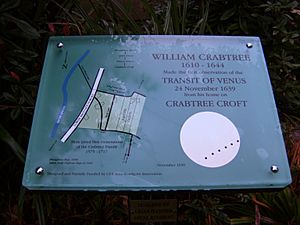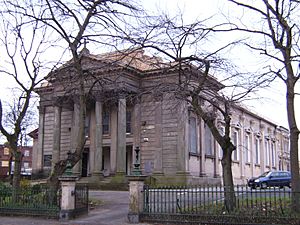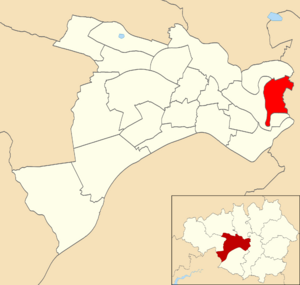Broughton, Salford facts for kids
Quick facts for kids Broughton |
|
|---|---|
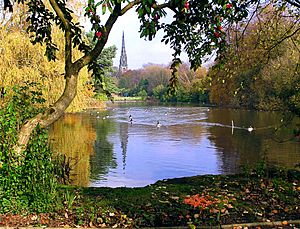 Clowes Park, Broughton |
|
| Population | 13,869 (2011 ward) |
| OS grid reference | SD828002 |
| • London | 165 mi (266 km) SE |
| Metropolitan borough | |
| Metropolitan county | |
| Region | |
| Country | England |
| Sovereign state | United Kingdom |
| Post town | SALFORD |
| Postcode district | M7 |
| Dialling code | 0161 |
| Police | Greater Manchester |
| Fire | Greater Manchester |
| Ambulance | North West |
| EU Parliament | North West England |
| UK Parliament |
|
| Councillors |
|
Broughton is a lively area and suburb in Salford, Greater Manchester, England. It sits on the east side of the River Irwell. It's about 1 mile (1.6 km) northwest of Manchester city centre and 2 miles (3.2 km) south of Prestwich.
Long ago, Broughton was part of Lancashire. It was a small area called a township and had its own chapel. The old manor house, Broughton Hall, was owned by important local families like the Chethams and Stanleys. Later, it passed to the Clowes family. Broughton joined the larger area of Salford in two stages, in 1844 and 1853.
Today, parts of Broughton have been rebuilt with new homes. Broughton is also known for being home to a large Jewish community, along with nearby areas like Whitefield, Prestwich, and Crumpsall.
Contents
History of Broughton
Ancient Times
People have lived in Broughton for a very long time. Tools from the Stone Age and other ancient items have been found here. A Roman road that connected Manchester (then called Mamucium) to Ribchester (Bremetennacum) passed through Broughton. Roman coins have also been discovered.
The area known as Broughton was first recorded in 1177 as "Burton." It was mostly surrounded by the winding River Irwell. The Manor of Broughton was once part of the honour of Lancaster, which was linked to the Royal Manor of Salford. Over time, different families owned it, until Henry Stanley, 4th Earl of Derby bought it in 1578.
Broughton in the 1600s
In the 1600s, Broughton was still seen as a small part of Salford. There was a pretty little village area with a spring called Broughton Spout. This was where William Crabtree, an amateur astronomer and mathematician, lived.
Crabtree was friends with another astronomer, Jeremiah Horrocks. Horrocks had correctly predicted a rare event: the transit of Venus across the Sun in 1639. Crabtree and Horrocks were the first astronomers to actually see and record this event on November 24, 1639. They both watched it from their own homes. Crabtree's careful calculations helped Horrocks figure out the size of Venus and how far the Earth is from the Sun. This observation is now seen as the start of modern astronomy in Britain.
In 2004, a street was named after William Crabtree to remember him. A plaque was also put up in 2005 near Ivy Cottage, which is believed to be where Crabtree made his important observations.
The Clowes Family and 1800s Growth
In 1772, the Manor of Broughton became owned by the Clowes family. By 1801, about 866 people lived in Broughton and nearby Kersal. Much of the land was owned by the Clowes family and the Byroms. The land was used for farming or for small home businesses like spinning and weaving.
Broughton Park was the Clowes family's large estate. A popular event each year was the Kersal Moor Races, which turned the Kersal area into a big fairground. Archery was also a popular sport, and the Broughton Archers were famous across the country.
During the 1800s, Broughton's population grew very quickly. The Clowes family carefully managed how the area developed. They allowed wealthy business people to buy large plots of land in Higher Broughton to build their grand homes and fancy terraces. By the mid-1800s, many professionals lived in an area called "the Cliff." This was one of the first places where people who worked in Manchester and Salford chose to live. Many of these old houses are still standing today and are protected as listed buildings.
In 1838, the Manchester Zoological Gardens opened in Broughton, but they didn't last long and closed in 1842. Many merchants from Europe and the Mediterranean Sea came to Manchester for business. By the mid-1800s, many successful merchants from the Ottoman Empire had settled in Higher Broughton. In 1861, they built the Greek Orthodox Church of the Annunciation, Manchester on Bury New Road.
Much of Lower Broughton was not built on at this time because it often flooded. One of the few houses there was even called "Noah's Ark" because it was built on a raised mound to stay above the floodwaters. The Church of the Ascension was built in 1869.
Broughton Joins Salford
In 1844, Broughton was officially made part of the Salford Borough. Some wealthy residents were against this, as they didn't want to be linked with "the cotton of Manchester or the filth of Salford," even though their money came from those towns.
Later in the 1800s, many terraced houses were built for workers, until all of Lower Broughton was developed. The Clowes family continued to control the area's growth to keep it "good class." Land in Higher Broughton was sold in large plots for big "villa" style homes. They also limited the number of pubs and only allowed beer to be sold, not stronger drinks. By 1901, the population had grown to about 49,048 people.
In the 1900s, many of the large houses were split into flats, and some areas became run down. Some beautiful Victorian terraces were knocked down and replaced with newer homes. In 1976, Salford City Council made "the Cliff" a conservation area. This helped protect the area's special character, with its cobbled streets and many fine old buildings.
Modern Changes
Since the early 2000s, Broughton has seen a lot of new development. In Lower Broughton, old local authority houses were updated with new gardens, fences, and porches. This made the area look much nicer. The council worked with residents to make sure the homes were good quality. Crime has gone down, and more people are finding jobs. This has made Lower Broughton a popular place for young people buying their first homes, especially since it's close to Manchester city centre.
In 2005, it was announced that some houses near Camp Street in Lower Broughton would be taken down to build brand new ones. This is part of a bigger plan to rebuild all council houses in the area, which is being done by Salix Homes and Countryside Properties.
Another project in Higher Broughton is called Broughton Green. Brentnall Primary School was knocked down as part of this plan. This school was on the site of a large house called Bella Vista, which had amazing views. It was built by a Greek merchant to show his importance. The house later became Broughton Grammar School for Girls before it was demolished for the primary school.
People of Broughton
Broughton has a large Jewish community. In the 2011 census, 14.2% of people living here said their religion was Jewish. This is much higher than the average for Salford (3.3%) and England (0.5%).
How Broughton is Governed
Broughton is part of the Salford City Council and is represented by three councillors. These councillors help make decisions for the local area. Currently, the councillors for Broughton are John Merry, Maria Brabiner, and Jim King. They are all part of the Labour Party.
Albert Park
Albert Park is a public park located near Great Clowes Street and Great Cheetham Street West. It sits between Higher and Lower Broughton. The park is named after Prince Albert, the husband of Queen Victoria.
Today, Albert Park has a large football pitch, a multi-use games area, a bowling green, an all-weather sports pitch, and a children's play area. It also has paths, shrubs, and many old trees. Albert Park first opened in 1877. It was described as having "16 acres of terraced walkways," meaning you could walk for 5 miles (8 km) around the park without going over the same path twice! The park used to have a 2-acre (8,100 m2) lake, but it was filled in during the late 1940s.
Sports in Broughton
Rugby
Broughton has a rich history in rugby.
- Broughton RUFC (formerly Broughton Wasps) was the first rugby club in Manchester. It was started in 1869 by former students of Broughton College. This club helped create the Lancashire Football Union.
- Broughton Park Rugby Union F.C. is one of England's oldest rugby union clubs, started in 1882. It has moved grounds several times and now plays in Chorlton-cum-Hardy. The club has many teams, from young children to adults, with over 320 players each week. It's the highest-ranked rugby union club in Manchester.
- Broughton Rangers started as a rugby union club in 1877. In 1895, they became one of the founding members of the Northern Union (which became rugby league). They later moved and changed their name to Belle Vue Rangers in 1946, but the club stopped playing in 1955. Now, they are being reformed with help from Salford RLFC.
- Mancunians RL, founded in 2009, also plays at Broughton Park.
Football
The Cliff in Higher Broughton was the main training ground for the famous English football team, Manchester United F.C., until 1999. It is still used today for some Manchester United junior and academy team matches.
Famous People from Broughton
Many interesting people have come from Broughton, including:
- William Crabtree (1610–1644): An astronomer and mathematician who was one of the first to observe and record the transit of Venus across the Sun.
- D. M. S. Watson (1886–1973): A professor of zoology and comparative anatomy.
- William Hickton (1884–1942): A cricketer.
- Al Read (1909–1987): A comedian, born and raised in Broughton.
- Elkie Brooks (born 1945): A famous singer.
- Mike Leigh (born 1943): A well-known playwright and director from Higher Broughton.
- Shelagh Delaney (1939–2011): A playwright, famous for her play A Taste of Honey.
- Ewan MacColl (1915–1989): A folk singer and writer, known for songs like "Dirty Old Town." He went to North Grecian Street Primary School.
- Liz Dawn MBE (1939–2017): An actress best known as Vera Duckworth in Coronation Street. She lived in Broughton Park for many years.
- Mark E. Smith (1957–2018): The singer for the band the Fall, originally from the Cliff.
- Ren Harvieu (born 1990): A singer from Salford.
- Peter Hook (born 1956): A musician and bassist for bands like Joy Division and New Order.
- Bernard Sumner (born 1956): A musician and vocalist for bands like Joy Division and New Order, from Lower Broughton.
- Graham Gouldman (born 1946): A songwriter and bass player for the band 10cc, from Broughton Park.
- Pat Phoenix (1923–1986): An actress best known as Elsie Tanner in Coronation Street, who lived in Broughton Park in the 1960s and 70s.
- John Cooper Clarke (born 1949): A poet and comedian.
- Mike Ward (born 1990): A singer-songwriter who appeared on the UK show The Voice. He grew up on the Cliff.
Images for kids



